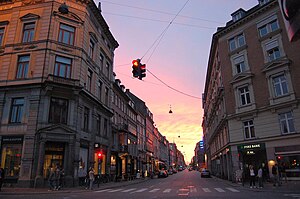Store Kongensgade

Store Kongensgade(Danish pronunciation:[ˈstoːɐˈkʰʌŋn̩sˌkɛːðə];lit. 'Great King's Street') is the longest street in centralCopenhagen,Denmark.[1]It extends northeast fromKongens NytorvtoEsplanaden,running parallel toBredgade,where it breaks left, continuing northwest toGrønningen.
Store Kongensgade is part of the Ring 2 thoroughfare. Traffic isone-way,moving fromØsterport stationto Kongens Nytorv, while traffic moving in the opposite direction goes by Bredgade which is also one-way.
History
[edit]
Store Kongensgade was established in 1663 in the area known asNew Copenhagen., a large expansion of fortified Copenhagen which had recently been created by giving the city's East Rampart a new course. The street connected the King's New Square, Kongens Nytorv, toFrederikshavn Fortress(now Kastellet), which had just been expanded. The name of the street was originally Ny(e) Kongensgade (literally: "New King's Street" ) since the city already had a Kongensgade onChristianshavnwhere present dayWildersgadenorth and south ofTorvegadewas known as Store and Lille Kongensgade respectively. The two streets received their current names in 1859.[2]
TheGuard Hussars' barracks was in the 19th century located at the northern end of the street, next to Kastellet. The facility was demolished in about 1900 and the site was built over in connection with the establishment ofGrønningen.The masterplan for the area was adopted on 29 June 1903. The smaller streets in the area have names associated with the island ofBornholm.[3]
Notable buildings and residents
[edit]Bernhard Hertz Sølvvarefabrik (No. 23) is a former silver factory created by the goldsmith Bernhard Hertz in 1782.[4]
TheDanneskiold-Laurvig Mansionat No. 58, from about 1745, is attributed to the German court architect Johann Adam Soherr.[5]Mecanicus Kretz' House (No. 67A-V) is a listed complex dating from the 1830s. TheDe Coninck House(No. 72) was built forFrédéric de Coninck,probably to design by the French architectJoseph-Jacques Ramée.
The building at No. 86-88 was built to an opulent, Historicist design byFerdinand Meldahlin connection with the rebuilding of theMarble Church.[6]The intention was to build an identical building on the opposite corner butCarl Frederik Tietgenwho sponsored the rebuilding of the church never managed to acquire the site. The building was for more than a hundred years left as an empty site and became Colloquially known as "Tietgen's Annoyance" ( "Tietgens Ærgrelse" ). In 2006,RealdaniachargedTony Frettonwith the task of designing a modern building which fitted into the historic environment. The building was completed in 2010.[7]
Christians Plejehus(No. 108) is a former hospital and workhouse built to design byCarl Pfluegin 1765 to 1769.[8]
The street has a colourful mixture of facades representing different periods and architectural styles. The last section of the street, north of Esplanaden, passes theNyboderterraces.
Public art and memorials
[edit]
At Store Kongensgade, in front of Nyboder, there is amemorial to Vice Admiral Edouard Suensonwho commanded the Danish ships in theBattle of Heligoland9 May 1864. The monument was designed byTheobald Steinand inaugurated on 9 May 1889.[9]It consists of a bust of Suenson mounted on a high plinth decorated with alaurel wreathandprows.On its front side, it has the inscription: "VICE-ADMIRAL/EDOUARD SUENSON/Vorn 13 APRIL 1805/DIED 16 MAY 1887 The foot of the plinth is guarded by bronze lions which hold acoat of armswith the inscription "HELGOLAND/9 MAY/1864".

At the pointed corner of Store Kongensgade and Grønningen, looking north, standsAnne Marie Carl-Nielsen'sPegasusstatue which commemorates her husband, the composerCarl Nielsen.[10]
A small triangular greenspace sponsored by M. Goldschmidt Holding was created in front of the company's head office on the corner of Grønningen and Store Kongensgade. It includes a bronze statue of the titanAtlaswhich was originally commissioned byCarl Jacobsenfrom the sculptor Nicolai Schmidt in 1899. It has previously decorated the roof ofCarlsberg's building inCopenhagen Freeportand later the Central Machine Building in theCarlsbergneighbourhood. The sculpture is used in M. Goldschmidt's logo.[11]
Cultural references
[edit]Store Kongensgade is used as a location in the 1977Olsen-bandenfilmThe Olsen Gang Outta Sight.[12]
Image gallery
[edit]-
Nyboder terraces
-
No. 122, opposite Nyboder (1906)
-
No. 124, opposite Nyboder (1908)
References
[edit]- ^"Store Kongensgade"(in Danish). indenforvoldene.dk.Retrieved2013-08-18.
- ^"Anekdoter fra det gamle Christianshavn"(in Danish). dengang.d.Retrieved2013-08-18.
- ^"Som bobler i champagne"(in Danish). Berlingske.Retrieved2013-02-07.
- ^"Sag: Bernhard Hertz Sølvvarefabrik".Kulturstyrelsen.Retrieved23 August2016.
- ^"Store Kongensgade 68-68a-b".indenforvoldene.dk.Retrieved23 August2016.
- ^"Store Kongensgade 86-88/Frederiksgade 1".indenforvoldene.dk.Retrieved23 August2016.
- ^"Tietgens Ærgrelse".Realdania.Retrieved23 August2016.
- ^"Christian Carl Pflueg".Dansk Biografisk Leksikon.Retrieved23 August2016.
- ^"Monument for Edouard Suenson".Dansk Center for Bt Historie.Retrieved2011-02-16.
- ^"Carl Nielsen statue".Open Copenhagen.Retrieved2013-02-07.
- ^"Pladsrenovering. Statue på plads"(in Danish). City Avisen.Retrieved2013-02-08.
- ^"Film 9 Olsen Banden deruda / Die Olsenbande schlägt wieder zu".olsenbande-homepage.de(in German).Retrieved5 October2017.



